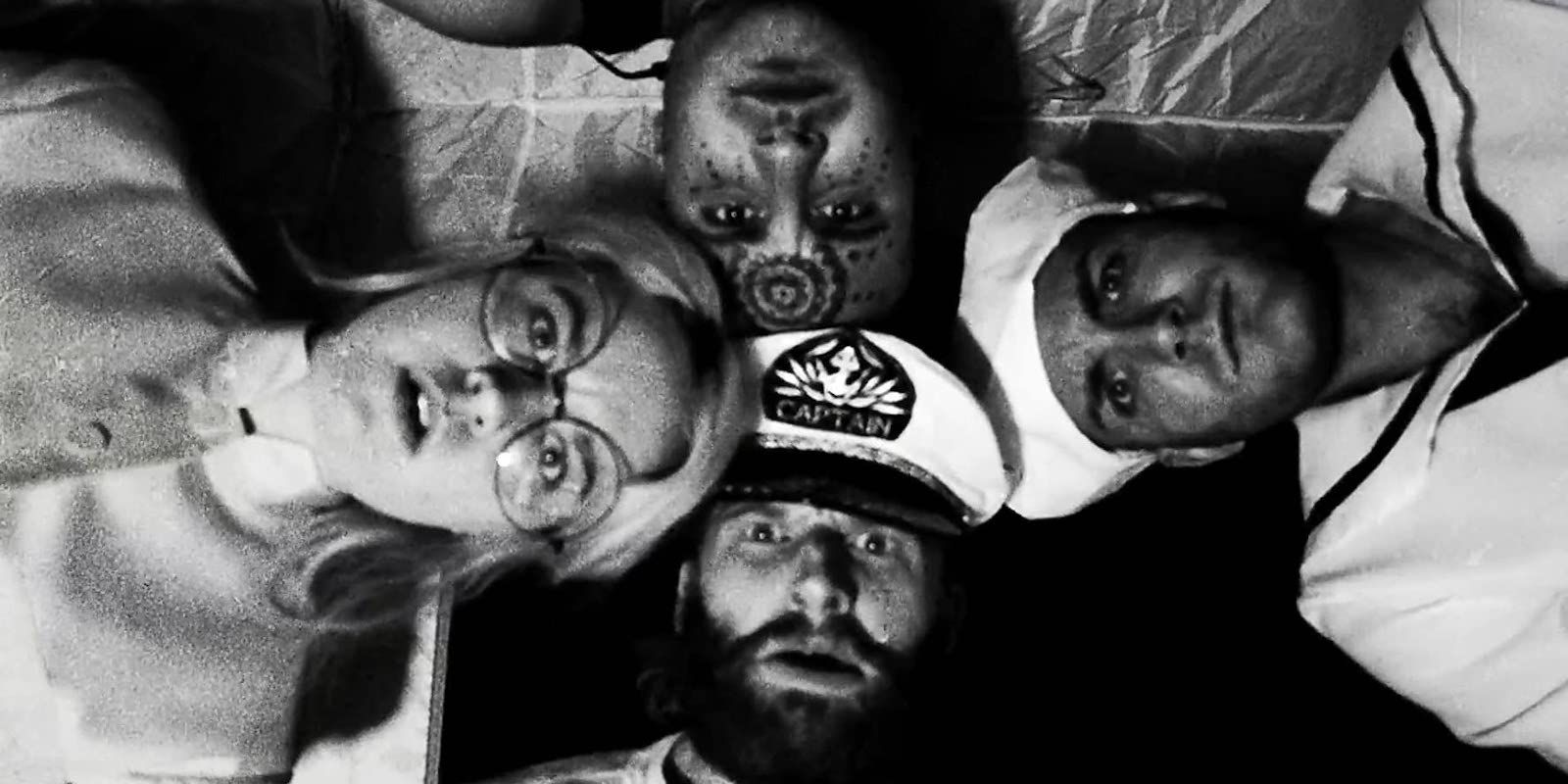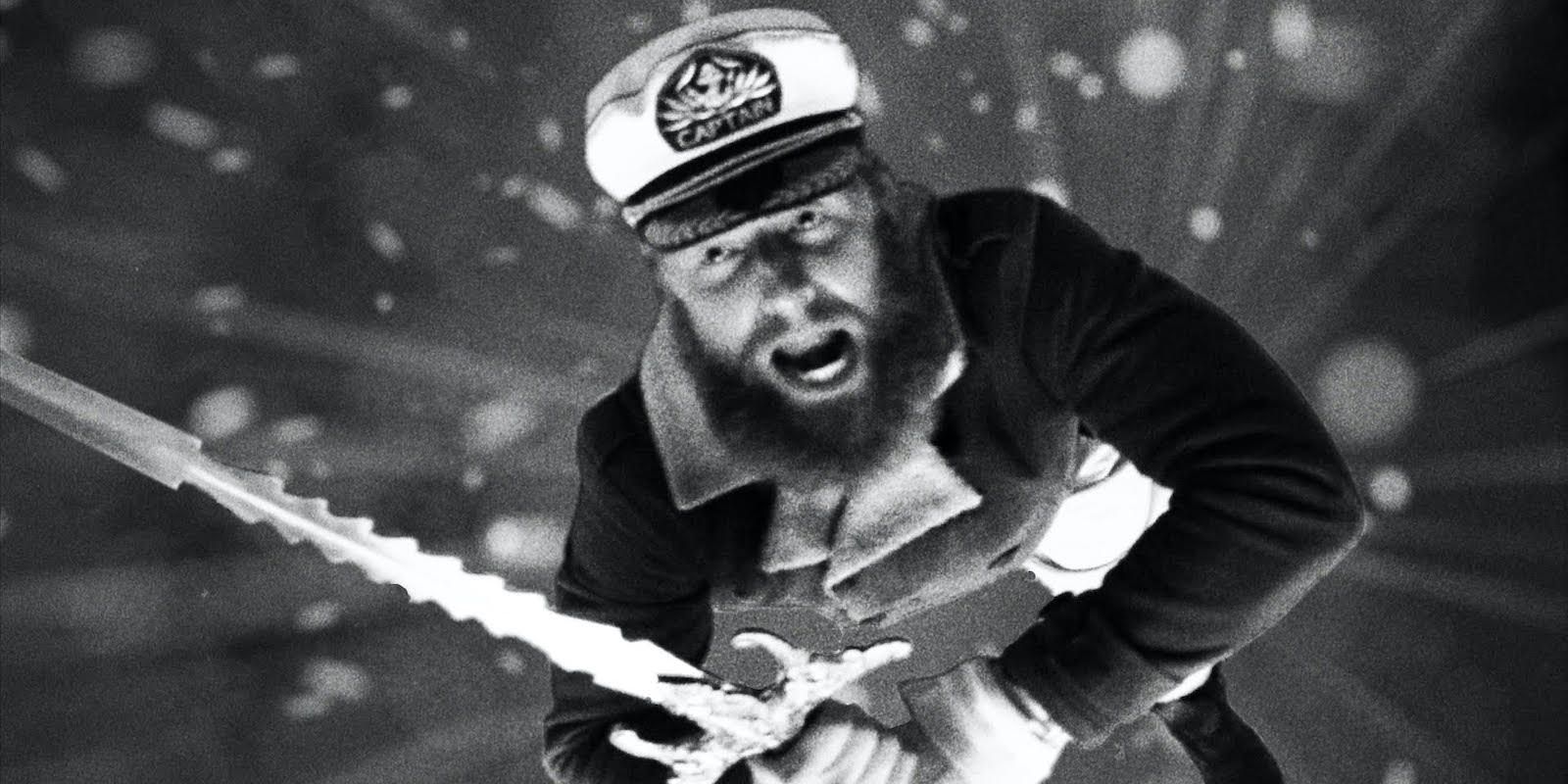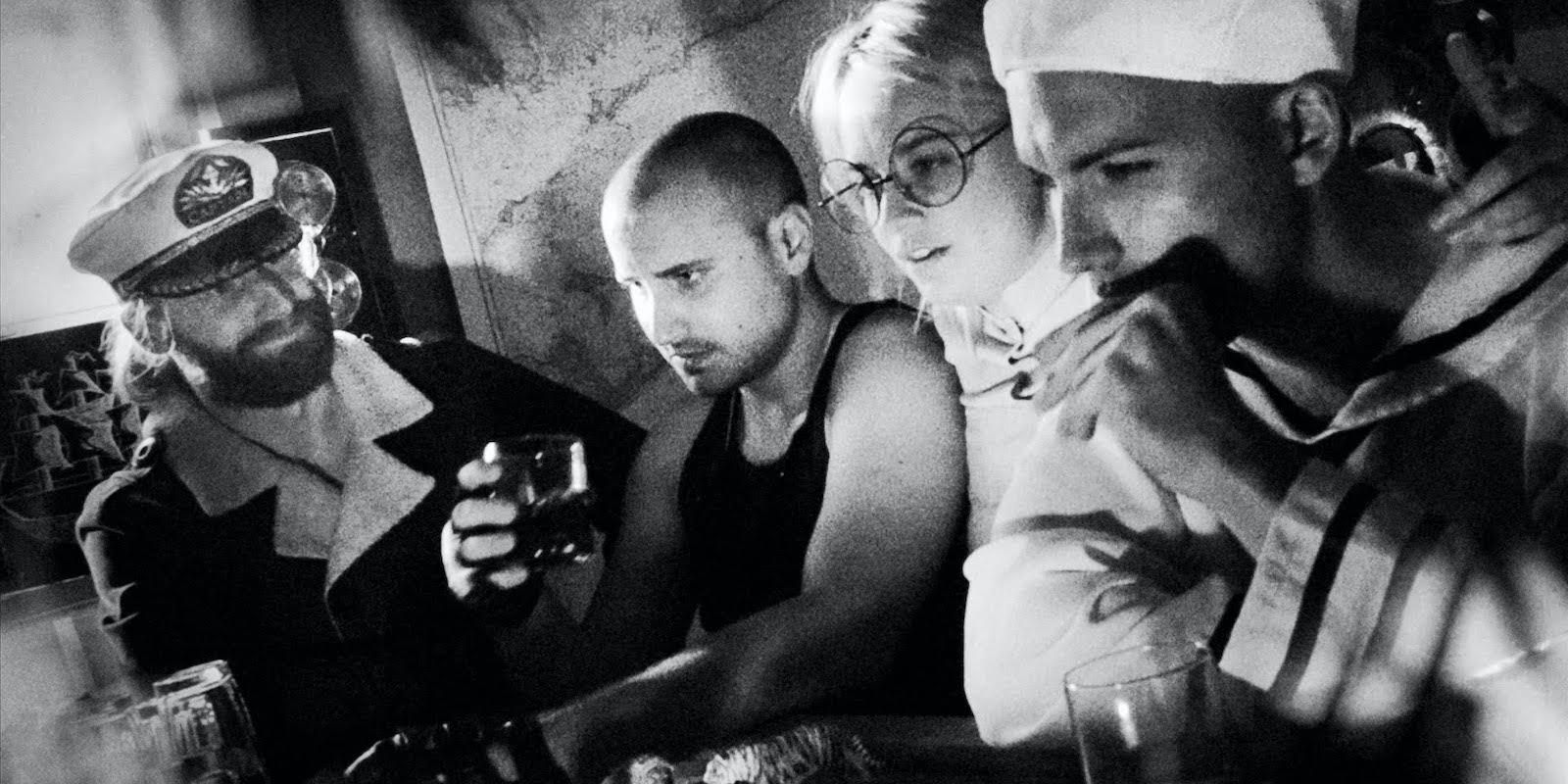The micro-budget Lake Michigan Monster is a movie that can be described in many ways: an absurd creature feature, a hilarious fever-dream, a cult classic in the making. No matter how you describe it though, the movie has won fans at film festivals all over the world with its zany, amusing story and its off-kilter aesthetic. The film is the brainchild of Ryland Brickson Cole Tews, who wrote, directed and starred in the movie as the eccentric Captain Seafield.
CBR spoke to Tews about how the story and unique visual style of Lake Michigan Monster were developed, what it's been like to see audiences respond to the movie and what's next for him. And for an added bonus, check out an exclusive clip from the film at the end of the interview.
How did Lake Michigan Monster come about?
The idea came actually when I was sitting on the shores of Lake Michigan one fall day with my buddy, Erick West who plays Sean Shaughnessy. And we were sitting on the shore... drinking wine and smoking cigarettes. And it was raining that day. And we had nothing better to do, so we were just taking in all the gloominess and the beauty that is Lake Michigan, and I said to Erick, I said, "You know, what would happen if a mermaid washed up on shore right now and we’re the only ones around to see it?" And from there, Lake Michigan Monster began.
That was the inciting incident that then led me to write and make a feature-length film called Lake Michigan Monster. So from there, I just got my friends on board. I said, "You know, I’m moving to LA in a year. I'm going to try to make a feature film before then." And, yeah, just kind of cast in all my favors with my friends and family and forced them to be in my movie. And then a little under two years later then, we had a finished film on our hands.
How did you go from a mermaid to a monster for the final film?
Well, the lake down there, Lake Michigan, sort of has this mysterious, intriguing vibe to it, just because it’s a giant lake and it’s very deep. And it’s like, "What’s going on down there?" And so that, coupled with the fact that the beach is just sitting there, anyone can go down to the beach and shoot at the beach, kind of got my mind rolling and thinking, "Well, let's take this mysterious, intriguing lake and take this location that we can shoot at freely and try to make a narrative out of it."
And again, like I said, with this mermaid idea in mind I kind of tweaked that to making it a monster. And so then, of course, naturally we got to, oh, it’s got to be a sea captain who wants to go after this monster and he's got to have a crew of people who want to help him. So, one thing just kind of led to another.
But it was just kind of an idea that seemed attainable. I structured the script and all the scenes around places that I thought I could shoot at. So really it was kind of an attainable idea. We could feasibly make a monster movie, feature length, for not a lot of money. And so that’s what we did.
How did you come up with some of the more fever dream-like sequences?
That was definitely an idea that the editor and producer and visual effects wizard, Mike Cheslik and I thought up…. We thought, "Well, we should have a dream sequence, but… it shouldn’t entirely make sense but it should be visually intriguing." And it was just kind of an idea we had of, "let’s just take it as far and wild as possible," because... when you don't have a big budget, you kind of have to throw the whole kitchen sink at the screen all the time.
You know, you have to bombard the audience with imagery or they're going to turn off the movie because it's only $7,000. They're going to see through it and they’re going to be bored, so you're always thinking, "Well we have to just constantly bombard the audience with new, exciting, weird imagery." And we also have to keep every scene moving. And we have to end every scene with a question mark, so it keeps the audience engaged, you know, guessing what's going to happen next.
And again, that was Mike, the editor, who was a big part of that, always wanting to keep the thing moving, never have any big lulls, creating that sort of spooky atmosphere, but never boring people, so that we were always very conscious of that… Yeah, just stuff that’ll keep people engaged and wanting to keep watching.
The movie has such a distinct visual style. How was that conceived?
Well, it was kind of out of necessity because the only camera we had access to was Beuleh Peter’s camera, who plays Nedge. We just used her old DSLR camera. But it’s like a Nikon D3100 so… the picture’s not that great, and we knew we couldn't compete with other indie movies who're shooting things on like an Alexa or whatever. So we went totally the opposite direction and we made it as just black and white and as grainy and scratchy as possible, because we thought it would stand out from the other six billion movies made every year.
So, it had its own distinct style and look, but it really was out of necessity because our camera wasn’t [that good]. But I think that overall then adds to that spooky atmosphere of it. And then Mike [Cheslik] again with his editing and visual effects background, he came in and he did over 300 effects shots on the movie, and this kind of more primitive look allowed him to do that many effects shots without it taking forever. We just thought well let’s just… dirty it up as much as possible because the camera’s not that great. So let’s just make it dirty to look at, but in so doing, it gave it its unique style and allowed us to do a lot of cool effects.
How did the design of all the effects come about, especially the sea monster? Was that planned in advance or did you see what you shot and then decide on what effects made sense afterwards?
It’s funny, we started shooting the movie and we got most of the movie shot before we really decided on what the monster was going to look like. In my original thinking of what the monster would look like, it was actually a lot different… Erick West, who’s Sean Shaughnessy, made the white claws in the movie but we didn’t know what the rest of the body was going to look like. So then, once we decided that we wanted to kind of make it come full circle, and it was this whole family thing…, then we realized it can’t just be a monster in the traditional sense, it has to resemble a certain member of the cast. So once we realized that, then we could start building the monster and figure out what exactly it would look like.
And then we got Joe Castro on board, who's been doing monster effects and creature suits and stuff for over 25 years. So once we hired him and he came on board, then it was a done deal. And I'm really glad we did get Joe on board too, because you know everything is so DIY in this movie…, but we definitely thought like, "Okay, if we're going to spend a decent amount of the money on something, it might as well be the monster, it might as well be the Lake Michigan monster. It should probably look good. It should be a satisfying monster to look at." So, yeah, that's what we did. We tried to make it unique enough too that it’s kind of something you’d never seen before, and I think we did a pretty good job of that.
How did you come up with the off-kilter tone of the movie with the asides and the moments of clarity? The dialogue is really, really fun to listen to.
Well, that’s good to hear. I don’t know, it’s just sort of my brand of humor, I guess, coming through. I guess I was subconsciously always... influenced by Monty Python and old Simpsons episodes and stuff…. Because we didn't set out trying to make a '50s creature-feature spoof. People kind of assume we did but we really didn't. And if we had done that we would have made all the dialogue much more melodramatic. And of course, you know Guy Maddin was a big influence visually to the movie but he has a whole other sense of humor too, a very dry, melodramatic sense of humor.
So we weren’t trying to make one of those movies, we just kind of borrowed visually what that looked like, but then I just implemented my own sense of humor, I guess, and just how I could picture my friends delivering these lines. You know a lot of it, it’s Beulah [Peters, who plays Nedge] and Erick [West, who plays Sean Shaughnessy] and Daniel [Long, who plays Dick], all their lines are kind of, this is the stuff that they would say in this situation. They kind of more or less play themselves in the movie, and because they're not classically trained actors and I didn’t want to give them too much to work with because, again, they were all doing this out of the kindness of their hearts, I kind of just wrote their characters as who they are in person anyway. So I didn't find that too difficult. But I guess what it comes down to is just my own sense of humor that shines through in the movie.
You starred in the movie in addition to writing and directing. Was that always your plan?
Yeah, that was always the plan because I would be the only one that would do it. First of all, I wanted to play [the character of] Seafield because I enjoy acting more than writing and directing to begin with. But also, there would never have been someone available to come in and be Seafield free of charge.
I already kind of felt bad about dragging my friends into this and just having them participate, and so I couldn't even imagine if I had asked someone else besides me to play Seafield, just because he's in like every single scene and there’s so many pick-up shots and just so many days where it was just me and a camera or me and Beulah with a camera. So, yeah, it was just always the idea that I would play Seafield. And much like the characters in the movie, all my friends would also come along on this strange Captain Ahab-esque voyage with me.
You really commit to the character. Was it a challenge to act while you were also directing?
No, it was fun. I never thought it was difficult, really. Probably just because I also wrote the dialogue, so when you're writing a scene you just keep saying the same line over and over to yourself until you think it’s good and you get it right. So, playing Seafield was a lot of fun, and doing whole scenes together with the other characters was a lot of fun. So, no.
I think the biggest challenge was directing because everyone you see onscreen was also working behind the scenes too, so we would only have three, four, five, maybe six people on set every day doing everything. So directing was definitely most challenging. But yeah, playing Seafield was just fun. He's such a goofy, crazy, out-there character that how can you not have fun with that?
The film has played at film festivals nationally and internationally since 2018 now. How has it felt to see audiences react to what you made?
It’s been amazing, you know. We never thought that it would be as successful as it’s been. Every time we’ve been to a screening, crowds have loved it. It's definitely, sort of an underground midnight pulp movie, so when you play it late at night with a bunch of people and everyone’s had a beer or two it definitely plays very well. We show it at bars too, and everyone gets a kick out of it. So, yeah, going to the fests has been a lot of fun. It’s just been great meeting everyone and the feedback has been tremendous.
But on top of that... we never expected it to go much of anywhere. And then all of a sudden, it's winning awards and then it’s in the big festivals, like Fantasia Film Festival, which was like our Super Bowl because it was like, "Wow. Can you believe our little itty-bitty movie made it into Fantasia, the king of genre movies?"And then inexplicably the movie wins the Gold Audience Award for Best International Feature, which is absurd. I'm pretty sure they played the wrong movie in our place. But, we won! So it’s been crazy. We always thought it’d play in some Wisconsin fests or Midwest fests or whatever, but like you said, it’s played all over the world. It's wild.
Do you have any new projects in the works?
Yes, we started shooting a new picture last winter, and we're going to continue shooting it the coming winter. It’s a supernatural, no dialogue physical comedy that takes place in northern Wisconsin during the height of America's fur trade, and the name of the movie is Hundreds of Beavers. And that one’s going to be directed by Mike Cheslik. Him and I had come up with the story together but, yeah, he's directing it and that one’s going good and that one should be ready to go at film fests hopefully next summer.
Did you write it or are you only starring?
I co-wrote it with Mike and I am also starring. It’s still going to be that same sort of black-and-white, grain-train style, as we call it, that Lake Michigan Monster was, but… it’s got a little better camera, it’s got a little bit more money involved in it, so I think it's going to be a step up from Lake Michigan Monster. But it’s still going to be a comedy, but just kind of a little bit of a shift away from Lake Michigan Monster tonally. I think it'll be a riot.
Lake Michigan Monster is written, directed and stars Ryland Brickson Cole Tews and co-stars Erick West, Beulah Peters, Daniel Long and Wayne Tews. It is currently available to stream on the Arrow Video Channel, which can be accessed on Apple TV in the UK and US and on Amazon in the UK.



